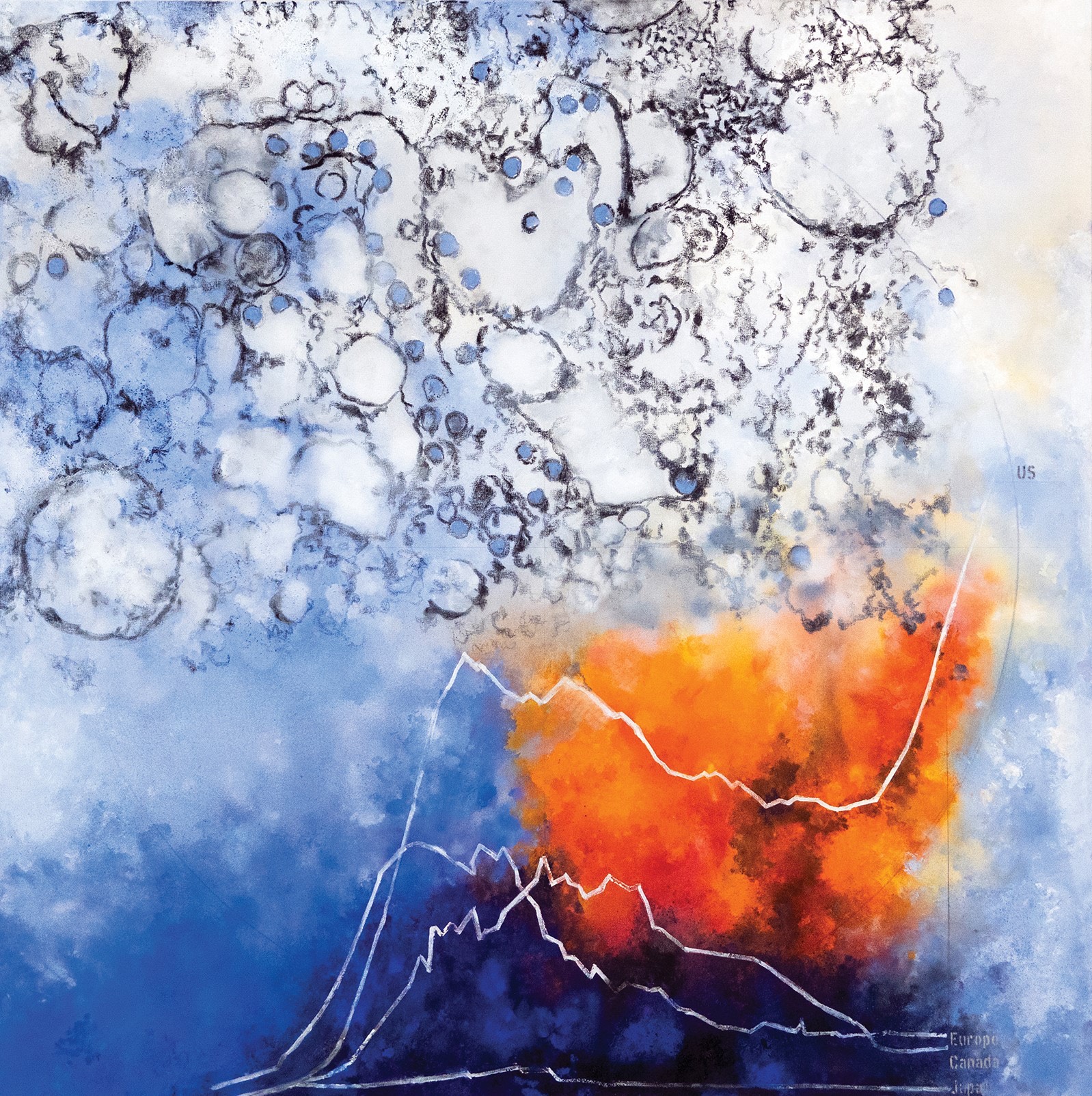
“JULY, 2020,” painted by Diane Burko, served as an experimental stimulus for a new
study on the power of art in science communication. Image via Issues in Science & Technology.
Communicators of science—journalists, educators, and researchers included—love a good
graph. We lay out results on X and Y axes, in histograms and scatterplots. We place
empirical data front and center.
But traditional graphs and charts are not the only way to communicate science visually.
Harnessing the expressive power of visual art is an increasingly popular approach
for conveying science-related information. And new research shows it may be a more
effective means of communication, in some ways, than classic data visualizations.
A recent study my colleagues and I published in the journal Science Communication reveals that on a popular social media platform, artistic representations of data
can be more effective at eliciting positive emotions than traditional graphs when
it comes to science-related topics like COVID-19.
But before diving more deeply into what we found, it’s helpful to contextualize our
experiment a bit.
The rise of the science-focused artist
Increasingly, artists are helping capture and communicate the emotion and significance
of scientific issues, such as climate change and the COVID-19 pandemic. One such artist,
Diane Burko, has become known for elaborate paintings, at varying levels of abstraction,
incorporating both scientific data and vibrant depictions of the issue. One of Burko’s
paintings was the basis for our experimental stimuli.
At the same time, artists today can reach much larger audiences than they could even
a decade ago. The emergence of visual social media platforms like Instagram enables
artists to reach more broad and diverse audiences than they might through a museum
exhibition or festival booth. Artists whose focus is on scientific topics can potentially
reach new people online and engage them emotionally on scientific issues of importance
to society.
But does this kind of art actually resonate with people? With the growing popularity
of science art on social media, we wanted to empirically explore some of the impacts
of art-based science communication.
Emotional impact
Our experiment was designed to compare individuals’ emotional responses to Burko’s
painting versus the original data graph embedded within it. The painting we chose,
“JULY, 2020”, contains a graph showing the number of COVID-19 deaths in multiple countries
during that time, with the US count soaring above all the others. (In her own Instagram
post sharing the piece, Burko called the US case spike “an excessive increase which
could have been avoided.”)
We set up four experimental conditions. Each participant viewed one of the following
images:
Figure 2 from Villanueva et al. (2024): Stand-alone images for gauging emotional responses
and interest. (A) Original Data Graph, (B) Edited Data Graph, (C) Original Artwork,
and (D) Edited Artwork.
But remember: we wanted to capture any potential effects within the realm of social
media. As such, we created four mockup Instagram posts, each with the same caption
briefly explaining what the graph shows. The only difference between the posts was
the visual element—or which one of the above images the person saw. This way, we could
untangle the unique effects of the art piece from the effects of the graph itself.
The specific effects we were looking for were both on people’s emotions and on their
engagement behaviors, like liking or sharing. We grouped emotions into positive (happiness,
awe, inspiration, enthusiasm) and negative (guilt, sadness, anger, anxiety, fear).
What we found
First, people who viewed the artwork reported significantly higher levels of positive
emotions than those who saw the traditional data graph. The art seemed to stimulate
positive emotions. Secondly, those heightened positive emotions made people more willing
to like or share the content on Instagram, as shown in the figure below.
Figure 4 from Villanueva et al. (2024): Results depicting the role of emotions in
mediating the relationship between art exposure and social media engagement behaviors.
Our results are undoubtedly encouraging for science communicators. Visual art can
be an effective tool for engaging audiences with important science issues on social
media. It can help connect with people with issues like COVID-19 on an emotional level.
At the same time, it’s important to note the limitations of our research, most notably
that it only captured responses to one specific piece of art by one American artist.
Much more work remains to examine the effects of differing artistic approaches across
cultural contexts. Nonetheless, our study found evidence of the power of art as an
avenue for science communication.
Today’s major threats to people and societies—climate change, pandemic disease—are
rife with scientific data. But these threats are also inescapably packed with emotion: the grief of a lost loved one, the hope for a new vaccine, or the awe inspired by
rapid scientific advances. Our research shows that art can enable people to tap into
these emotions and connect with science on a deeper level.
References
Villanueva, I. I., Li, N., Jilk, T., Renner, J., Van Matre, B. R., & Brossard, D.
(2024). When Science Meets Art on Instagram: Examining the Effects of Visual Art on
Emotions, Interest, and Social Media Engagement. Science Communication. https://doi.org/10.1177/10755470241228279.
Please enable JavaScript to view the comments powered by Disqus.